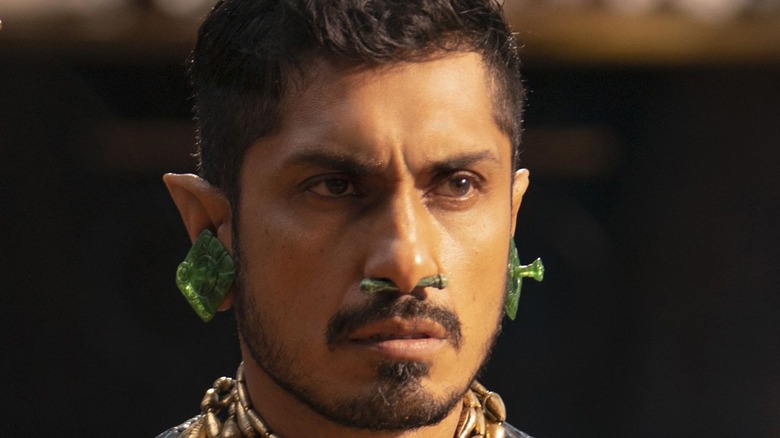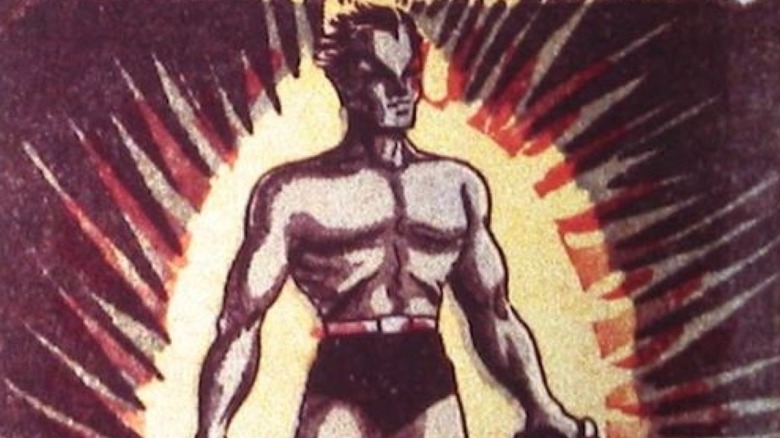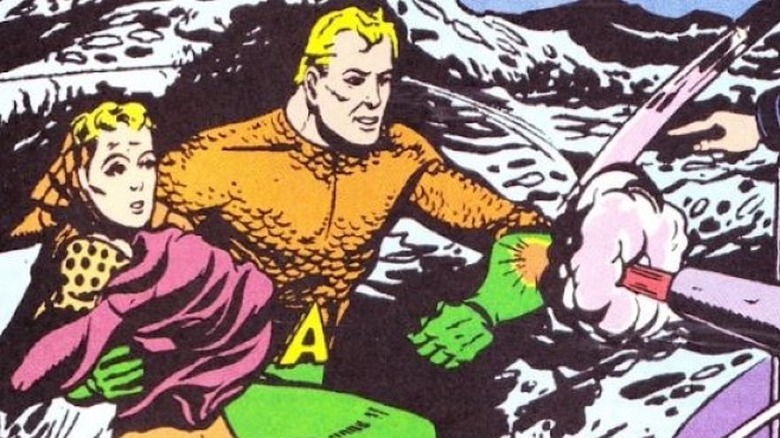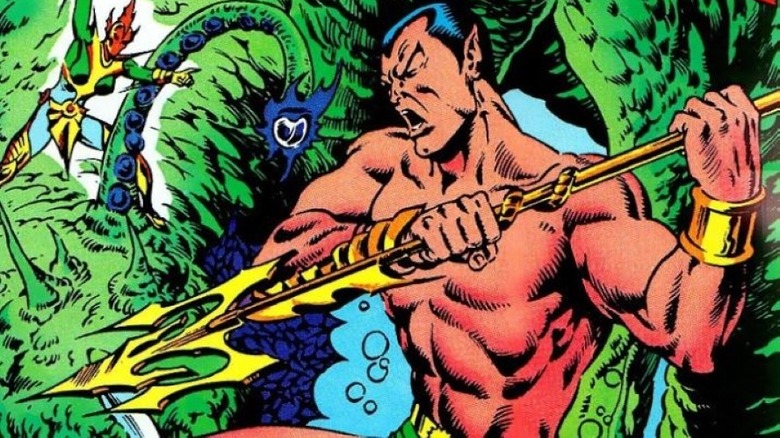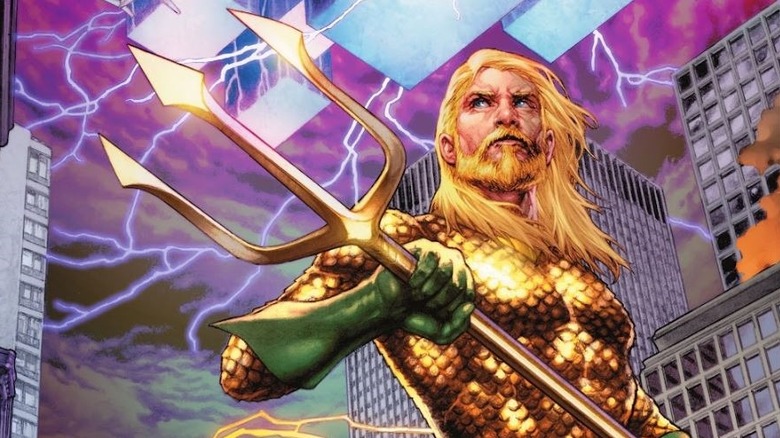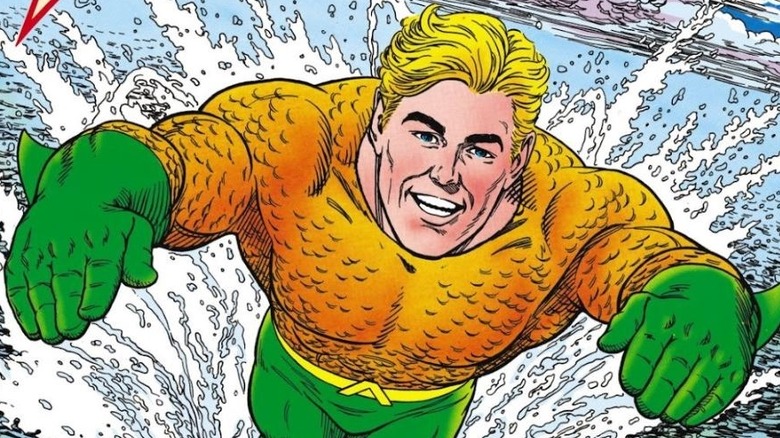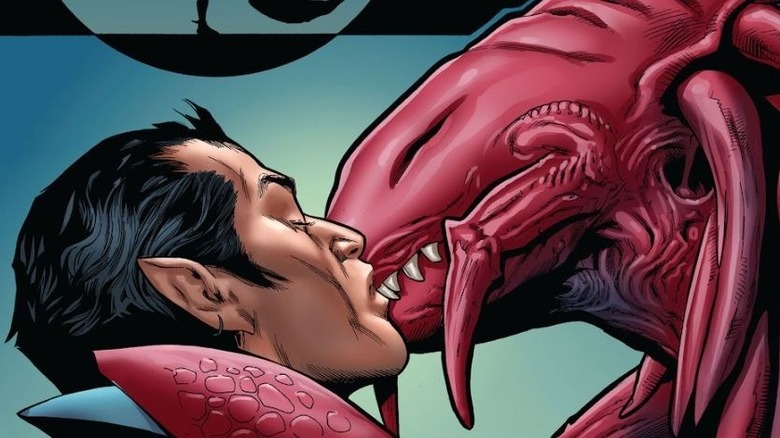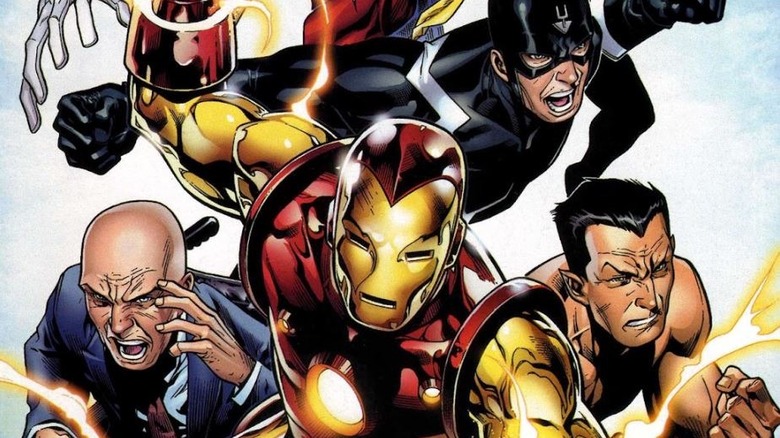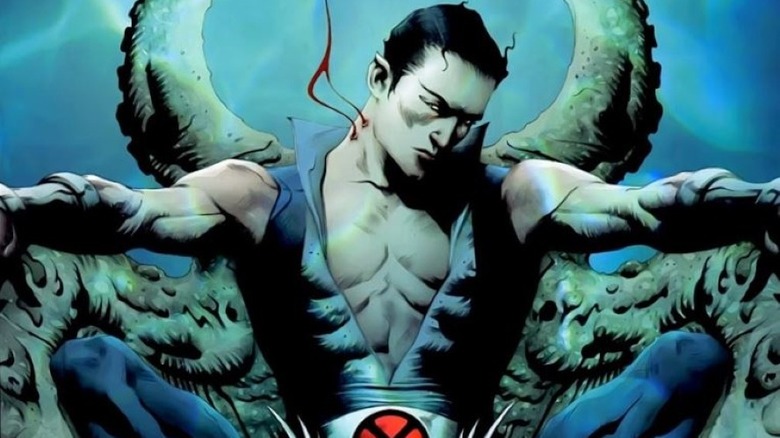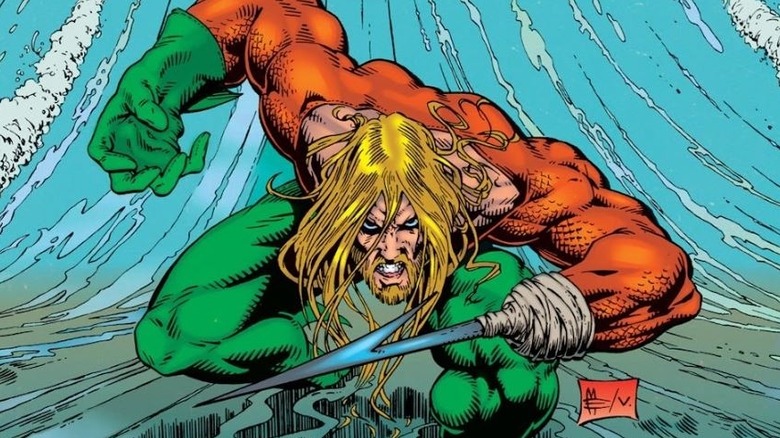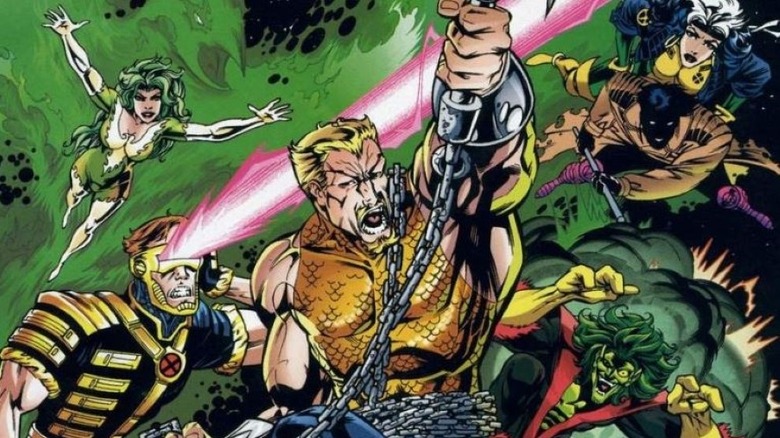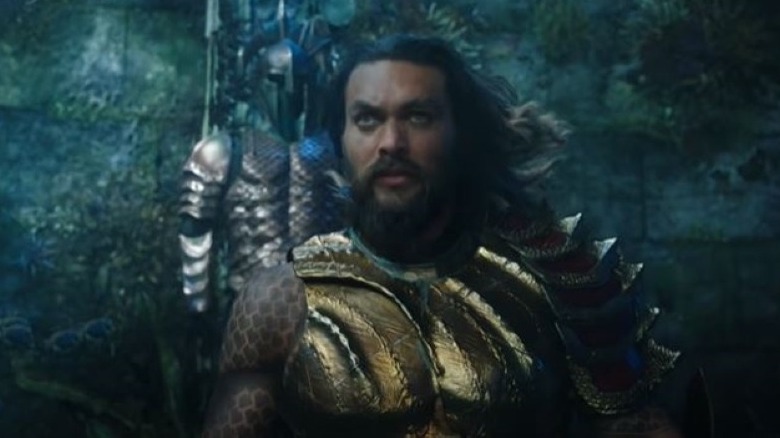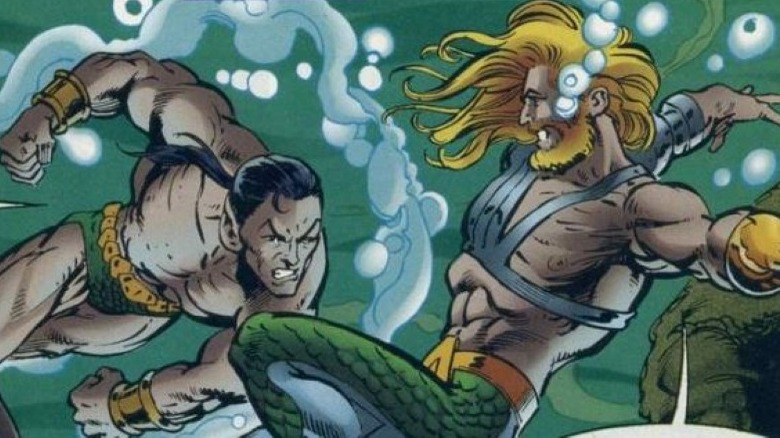The Biggest Differences Between Marvel's Namor And DC's Aquaman
It may have taken longer than expected, but audiences have finally received big-screen adaptations of comic book's two most significant water-dwelling heroes, DC's Aquaman and Marvel's Namor, the Sub-Mariner. Jason Momoa's Aquaman has been splashing around the big screen in movies like "Justice League" since 2017; Marvel fans waited for the comics company's (tied for) oldest character to wade into the MCU, and he finally arrived via Tenoch Huerta's watertight performance in "Black Panther: Wakanda Forever."
The two largest publishing companies share many near-identical superheroes (Black Cat vs. Catwoman, Thanos vs. Darkseid, Swamp Thing vs. Man-Thing, Deadpool vs Deathstroke), perhaps none so clear as these two water rulers. On first inspection, Aquaman and Namor are only distinguishable because of their appearance, representing the same theme and mythology for two unique universes. Both royals of the lost kingdom of Atlantis share several commonalities, including powers, origins, and impact on the land around them. Under the surface, however, there is more separating DC's powerful H2-hero from Marvel's aquatic powerhouse than expected.
Knowledgeable comic enthusiasts have more than 60 years of literature to help identify the differences between the contrasting sea kings. Thankfully, you won't have to spend hours sifting through pages and panels to decipher the variations between the two marine-themed demigods. Continue reading for a primer on Aquaman and Namor, then decide which is your favorite.
Who came first?
When it comes to debating two similar characters from rival publishing companies, being first is everything. Bragging rights go to the company that seemingly created a character out of the ether, while the others may forever be deemed a copycat.
In this case, Marvel wins the 'I got there first' argument, with Namor, the Sub-Mariner originally appearing in the first issue of "Marvel Comics" published in August 1939. The issue is the first comic ever released by Timely Comics (the predecessor to Marvel), making Namor the earliest character in the company's celebrated history — well, technically tied with the Human Torch, who debuted in the same issue. Essentially, the Marvel Universe was built around the Sub-Mariner and the Human Torch.
Aquaman, also known as Arthur Curry, entered into an established universe of comics when he first appeared in 1941 with issue #73 of "More Fun Comics." Joining characters like The Spectre, Doctor Fate, and Green Arrow, the aquatic king printed under the umbrella of National Comics Publications, which eventually morphed into DC Comics. Despite the staggered entrances into the comic book realm, Aquaman is not a direct rip-off of the Sub-Mariner. Truthfully, both characters take inspiration from oceanic myths and legends such as Atlantis, mermaids, and in Namor's case, the Samuel Taylor Coleridge poem "The Rime of the Ancient Mariner."
Origins and mythology
Breaking through the surface, both Namor and Aquaman are more than just royal figures to their respective underwater kingdoms. They have complex backgrounds and origins that define them as unique characters. Aquaman, specifically, has a complicated history, as his origins have been reimagined several times throughout his publication.
beginning as the son of a famous underwater explorer who raised him under the sea, the backstory was later changed to his father being a lighthouse keeper who married an exiled citizen of the underwater city Atlantis. After DC reorganized its continuity in the aftermath of "Crisis on Infinite Earths," Arthur Curry's origins were finalized into how they are understood today. As detailed in "Aquaman Special" #1, the character was born to the Queen of Atlantis and the wizard Atlan. Outcasted by his people because of his cursed blond hair, Aquaman was adopted by a human lighthouse keeper. Raised to embrace the surface world, he grew up to become a champion of Earth while taking his rightful place as King of the underwater empire.
Meanwhile, in the Marvel Universe, Namor McKenzie was born to an Atlantean Princess Fen and a human father making him the company's first mutant. Believing the father deceased, Fen raised Namor in the underwater kingdom of Atlantis where he learned to despise the surface world and would eventually take his rightful place on the throne. Despite often assisting the heroes of Earth, the Sub-Mariner's efforts serve the best interests of his aquatic nation.
Differences in abilities
As genuine superheroes, Namor and Arthur Curry maintain a standard set of powers, including superhuman strength, enhanced endurance, and formidable hand-to-hand fighting capabilities. Additionally, their hydro-dwelling origins grant them hybridized talents such as enhanced swimming, the ability to breathe underwater, and surviving the extreme pressure of the deep sea. However, from there, the powers and abilities of these oceanic monarchs begin to diverge.
In the DC realm, Arthur Curry has a long list of impressive powers, including marine telepathy, electroreception, and super speed. And while the Sub-Mariner shares these abilities, they are less potent. Additionally, Aquaman has a few tricks up his sleeve that are absent in the Marvel original, such as magic exploitation, heat resistance, and a connection to the life force that binds the oceanic world around him.
In contrast, Namor's strength in manipulating water and weather is much more potent than the DC aqua king. An ability to fly, granted to him by the small wings on his heels, is unique not only between these two characters but all representations of Atlanteans in comic books and one of the defining factors that categorize Namor as an Alpha-level Marvel mutant. It also mercifully frees Namor from the oft-joked about Aquaman's dependence on asking other heroes for a ride.
Two unique tridents
Another similarity that Namor and Aquaman share is their choice of weapon, the three-pronged spear traditionally used for fishing known as the trident. The preference makes sense, as the trident is often presented in representations of both the Greek and Roman gods of the sea, Poseidon and Neptune. Coincidentally, despite the many representations of the trident in mythology, both comic book ocean champions utilize the Trident of Neptune, although they differ in powers and history.
The Marvel Trident of Neptune is an ancient weapon used by the Sub-Mariner and is made of Enchanted Adamantine. However, the one currently used by Namor is a copy of Neptune's original, which was buried with the god after his death. While this ancient spear has magical abilities to manipulate water and shoot mystical beams, Namor most commonly uses it as a blunt object. Often depicted without the trident, the Atlantean hero uses it more as a symbol of his status.
On the other hand, Aquaman's Trident of Neptune serves as a much more powerful weapon. Made from Nth metal, the weapon is strong enough to damage gods and is more comparable to Thor's hammer, Mjolnir. Imbued with powerful magic, Aquaman is rarely seen without the trident nearby and uses it as a conduit for his own abilities.
Personality clash
Inarguably, the most significant defining factor separating Marvel's Sub-Mariner from DC's iconic Aquaman is their near-opposite personalities. Arthur Curry, who opts to fight crime in a bright orange uniform, has been portrayed with a range of characteristics. Sometimes a light-hearted adventurer, he has also been portrayed as a hardened monarch whose only interest is the sea and his empire within. But traditionally, Aquaman serves as a one-dimensional superhero overshadowed by his more interesting teammates. It is the character's lack of depth, inept style, and strange set of powers that often make him a target of insult by comic enthusiasts.
In opposition, Namor, the Sub-Mariner, is anything but a straightforward superhero and is more commonly represented as the villain. Perhaps best described as an anti-villain, Namor's placement in the Marvel Universe has always centered around his political placement as a royal representative of the ocean. Despite collaborating with a wide range of characters, the Sub-Mariner has developed a reputation for being difficult to cooperate with because of his self-centered, frequently aggressive attitude – especially against people from the surface world. Playing by his own set of principles has helped the character evolve from being another commonplace villain to an interesting, dynamic inclusion to the Marvel Universe as a whole. Perhaps most notably, the aquatic powerhouse would never be caught wearing an orange swimsuit; he instead opts for leather-clad armor, if wearing much at all.
Opposites in love
Although Aquaman and Namor share an unshakable bond with the sea, the two characters couldn't have a more opposite love language. Arthur Curry is as monogamous as a comic book character can come, bonded with his long-time love interest Mera in nearly every iteration. Serving at the hero's side, Mera is Queen of Atlantis and a former member of the Justice League. Loyal to Aquaman, she has been at his side through nearly every major event, and was an integral inclusion to the Jason Momoa-led feature "Aquaman," where she was portrayed by the controversial Amber Heard. The only other character that Arthur Curry has been legitimately romantically attached to is Wonder Woman, where during the "Flashpoint Paradox," the two royals allied their powerful nations.
Meanwhile, Namor, the Sub-Mariner, could be considered one of the most promiscuous characters in the Marvel Universe. Most prominently, the sea prince has tried on multiple occasions to break up Marvel's first family, the Fantastic Four, to gain the hand of Susan Storm, the Invisible Woman. Namor has been married twice, including once to his cousin Dorma. Additionally, Namor does not have any specified interests in potential mates, dating humans like Sandra Pierce, the mutant Emma Frost, and most disturbingly, a grotesque fish-like monster.
Their chosen super teams
Much as Aquaman is loyal in romance, the character does not break away from his oath to the Justice League. Situationally, the elite supergroup is a fitting place for the hydro-hero as he maintains his obligations under the sea. Unlike other superhero team-ups, Justice League members traditionally operate as individuals unless a situation requires the group to assemble. Appropriately, as part of the original six Leaguers depicted in "The Brave and the Bold" #28, Aquaman is typically considered a founding member of the Justice League, with some variations on the origin story exchanging the character for more modern creations.
Also fitting to his personality, Namor is as polyamorous with his super team allegiances as he is with his romantic affairs. The character has been affiliated at one point or another with nearly every super squad Marvel has to offer. One of the original members of the World War II-era Invaders, the Sub-Mariner has joined the ranks of The Avengers, Fantastic Four, Heroes for Hire, and is a founding representative of The Defenders. Further, Namor's mutant status has seen him lend his power to the X-Men, and subsequently join spin-off factions such as the Pheonix Five and Dark X-Men. Above all, the royal Atlantean held a seat at the most influential supergroup of them all, the Illuminati, where even there he switched sides to form a rival faction known as The Cabal.
Impact on their respective universes
Undoubtedly, Aquaman has been a force for good in the DC Universe. Despite the character being one of the most mocked superheroes in popular culture, he has consistently remained as pure and just as DC's golden pony, Superman. There is little doubt that the citizenry of the DC comics world respect the Atlantean king as a champion, if not a god. Far fewer nice things could be said about Arthur Curry's Marvel counterpart, as Namor is a name to be feared in his universe.
Certainly, the Sub-Mariner has made serviceable contributions during his time serving on Earth's mightiest super teams. But the character has no quarrels in reminding anyone that his actions are only to serve Atlantis and his own selfish gains. The Sub-Mariner despises the surface world and has made more than one attempt at leading his nation into invasion. In recent years, he has brought his people to war with the sovereign nation of Wakanda, akin to the storyline of "Black Panther: Wakanda Forever." Ultimately, Namor's moral compass offers a sort of demented balance, acting terribly towards the surface world just as frequently as he has come to its defense.
Whose comic stack is bigger?
Comic books are more than just a quick read; they illustrate legacies of powerful demigods, forming a collection of mythical feats and adventures that adapt over time with the audience. The best comic characters in the world have multiple titles, grace many memorable covers, and have their hands in the universe's most significant events. Naturally, a comic book character is defined by how often they are depicted and how many appearances they have made.
In the competition of who has a higher stack of comics with their name on it between Namor and Aquaman, the winner is a bit shocking. Although getting a 10-year head start, being inherently more complex and interesting, and having membership cards for every superhero team, Sub-Mariner's collection is drowned by Aquaman's appearances. Unfortunately, as a villain, Namor rarely earns a self-titled series under Marvel, leaving his cameos limited to other characters' books. Meanwhile, Aquaman has had his face plastered across multiple self-titled runs.
Amalgam Comics' Aqua Mariner
For a brief period in the mid-'90s, Marvel and DC Comics made history by putting their long-standing rivalry aside long enough to produce a series of titles making boundary-breaking hybrids of the world's most beloved comics characters. Under the badge name Amalgam Comics, heroes like Batman and Wolverine were blended to create original characters like Dark Claw. Not to miss the prime opportunity, Amalgam Comics capitalized on the undeniable similarities between the two champions of Atlantis from different universes. Namor McKenzie, the Sub-Mariner and Arthur Curry's Aquaman were crossbred into the ultimate ruler of Atlantis: Aqua Mariner.
True to form, the Aqua Mariner is an established character in the Amalgam Universe and a member of the Judgment League Avengers alongside characters like Iron Lantern, Doctor Strangefate, and Super-Soldier. However, Aqua Mariner found himself ousted by the squad when he was framed for destroying an oil tanker. Dividing the original team, Aqua Mariner's metamutant colleagues joined him in leaving the JLA to form a new team, the JLX.
MCU's Namor vs DCEU's Aquaman
Thanks to the rise in popularity of comic book-adapted films, these two water-themed superheroes have finally been allowed to make a splash on the big screen. Despite Marvel's efforts to produce a Sub-Mariner movie as far back as 1997 (per Variety), and further efforts within Universal in the early '00s; following the fictional blockbuster efforts of James Cameron, Aquaman made the initial plunge in 2017. First appearing in a teasing capacity in 2016's "Batman v Superman: Dawn of Justice," Jason Momoa's take on the aquatic icon was an essential piece of 2017's "Justice League." Following up on his arrival, Momoa headlined two "Aquaman" features and made a number of DCEU cameos before the cinematic universe was officially shuttered.
Meanwhile, the Sub-Mariner's arrival in the MCU was a long time coming. Considered for a role in "Doctor Strange in the Multiverse of Madness" as a member of the Illuminati (per Variety), the character was reserved for his breakout in "Black Panther: Wakanda Forever." However, Namor had some significant shoes to fill as the villain in the "Black Panther" sequel after Michael B. Jordan's portrayal of Killmonger was considered one of the best performances of a bad guy in the MCU. Tenoch Huerta's performance has also impressed audiences, and Namor's influence on the cinematic universe going forward seems to be as unavoidable as a tidal wave.
Who would win in a fight?
Every conversation about two superheroes has to eventually yield to the big question: Who wins in a fight?
Certain to be the biggest war that the oceans have ever seen, there are debates to serve either side. Aquaman and his cohorts in the Justice League are better represented as gods in their universe, whereas Marvel superhumans are often treated as flawed mortals. However, Namor is not the average Marvel character and is evenly matched against his DC counterpart. Meanwhile, Sub-Mariner's darker side would assure that no punches were held back. Counteractively, villains have a terrible record for winning fights in comic books.
Truthfully, these two characters could easily match each other blow-for-blow; it is, inarguably, one of the fairest fights DC Comics and Marvel could publish.
So, of course, they did. Aptly titled "DC versus Marvel," the 1996 four-part miniseries was a dream collaborative project for superhero enthusiasts. Reading like a kid playing with toys, the issues featured one-on-one battles between some of the biggest names in comics. "Round Two" of the miniseries put the lords of the seas in a grudge match showcasing how compatible they are in terms of strength and power. Ultimately, Aquaman won the day — utilizing the hilarious, yet underhanded, tactic of dropping a full-grown killer whale onto his opponent.
